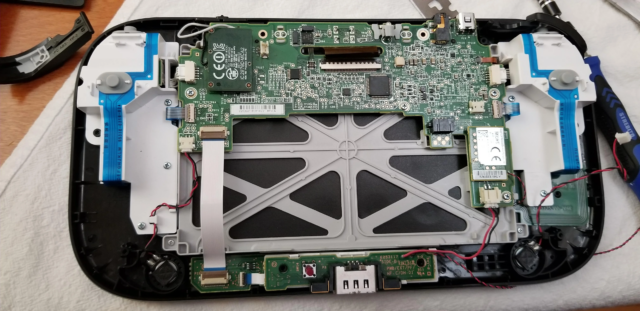The Frankenstein’s monster of a GamePad hack responsible for the creation of Trimming the Herbs.
Ahoyo
A cardboard box provides the inelegant case for Ahoyo’s Arduino-and-breadboard TAS solution.
Ahoyo
Close-up of the Arduino connections necessary to control the Wii U GamePad.
Ahoyo
Ribbon cables feed into holes cut through the back of the gamepad to connect directly to the mainboard.
Ahoyo
Last month, the Super Mario Maker community was rocked by the shocking admission that the game’s last uncleared level—an ultra-hard reflex test named “Trimming the Herbs” (TTH)—had been secretly created and uploaded using the assistance of automated, tool-assisted speedrun (TAS) techniques back in 2017. That admission didn’t stop Super Mario Maker streamer Sanyx from finally pulling off a confirmed human-powered clear of the level last Friday, just days before Nintendo’s final shutdown of the Wii U’s online servers Sunday would have made that an impossibility.
But while “Trimming the Herbs” itself was solved in the nick of time, the mystery of the level’s creation remained at least partially unsolved. Before TTH creator Ahoyo admitted to his TAS exploit last month, the player community at large didn’t think it was even possible to precisely automate such pre-recorded inputs on the Wii U.
The first confirmed clear of Trimming the Herbs by a human.
Now, speaking to Ars, Ahoyo has finally explained the console hacking that went into his clandestine TAS so many years ago and opened up about the physical and psychological motivations for the level’s creation. He also discussed the remorse he feels over what ended up being a years-long fraud on the community, which is still struggling with frame-perfect input timing issues that seem inherent to the Wii U hardware.
“I see discussing it as sort of a reputation damage control,” Ahoyo told Ars. “I saw value in the ‘ruckus’ that TTH would cause, in that it would bring in outside eyes to look at SMM with uncertainty and excitement… but it was a betrayal of my competitive values.”
Hardware hacking
Ahoyo recalled first hearing of the possibility of a Super Mario Maker TAS in “late 2015 or early 2016” when a viewer of his Twitch streams messaged him about a Wii U TAS project they had been tinkering with. In response to a follow-up in June 2016, the viewer sent a video “showing a controller attached to a Raspberry Pi and showed how it was controlling Mario on the screen,” Ahoyo told Ars.
While the viewer told Ahoyo they had since “abandoned” their efforts to get reliable TAS recording on the Wii U, Ahoyo said he “showed the video of their hardware to my friend, and he told me he thought it would be easy to replicate, so after an Amazon order, he built it.” This kind of level of automation was “not something I [had] thought about before,” Ahoyo said. “In the video demo I was sent about the TAS, it appeared to me like it was working fine. I thought it was a waste to abandon the project, so I pursued it spontaneously. I was just at the right place at the right time.”

Enlarge / The inner workings of the Wii U GamePad mainboard.
As you can see from the pictures atop this article, setting up a Wii U to play back pre-recorded inputs isn’t exactly a plug-and-play affair. Ahoyo’s setup involves an Arduino with multiple external connections to a breadboard, each one representing a button on the Wii U GamePad. Those outputs are first fed into a pair of 10-pin converter boards, then directly onto the Wii U gamepad mainboard via ribbon cables (fed through holes cut into the existing rear mounting holes on the GamePad). A separate set of colored physical buttons connects to the breadboard to control the playback of the TAS scripts through the Arduino, Ahoyo said.
“It turns out my hunch was correct; this was a bespoke, hand-crafted solution specifically for Super Mario Maker,” tool-assisted speedrun expert and TASbot keeper Allan “dwangoAC” Cecil told Ars after seeing the setup. The solution Ahoyo and his friend rigged up “isn’t general purpose in any way that likely wouldn’t have worked for anything else,” Cecil added.
>>> Read full article>>>
Copyright for syndicated content belongs to the linked Source : Ars Technica – https://arstechnica.com/?p=2015151










